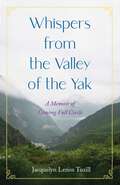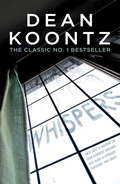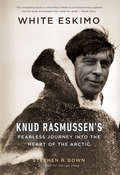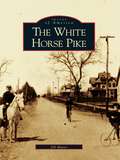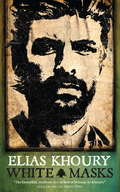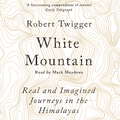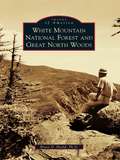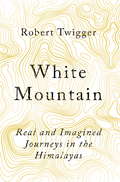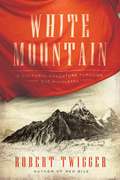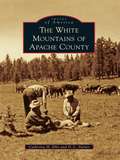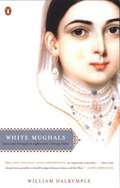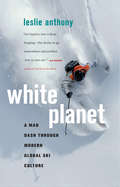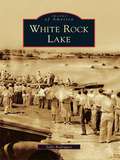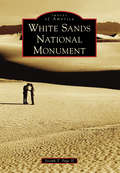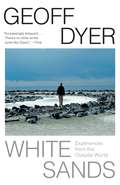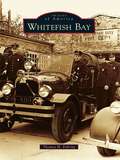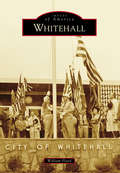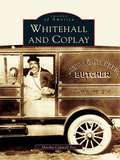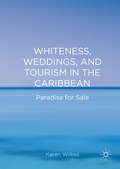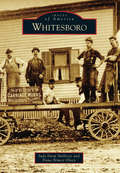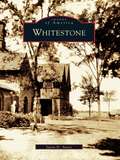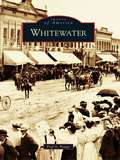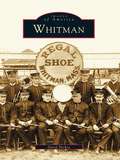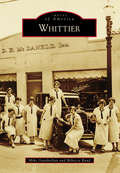- Table View
- List View
Whispers from the Valley of the Yak: A Memoir of Coming Full Circle
by Jacquelyn Lenox TuxillJackie, born of medical missionaries in China during World War II, rejected her connection to her birth country growing up because it made her different. A return to China with her parents in 1980, however, is life-changing. After always having known her mother as distant and emotionally abusive, she is stunned to see a loving side to her for the first time—and pleasantly surprised by the affinity she feels for her birth country.These revelations launch Jackie on a quest to understand her difficult childhood and who she is beyond &“wife,&” &“mother,&” and &“daughter.&” Her journey takes her first to the mountainous landscapes of Alaska, where she finds a passion for nature and begins a thirty-five-year environmental career. As she builds her life there and later in New England, she makes multiple trips to her birth country—with her parents, alone, and with her adult children. Each of these trips provides a benchmark for the growth and transformation she undergoes as she learns to create the authentic life she craves. Deeply reflective and sensitively rendered, Whispers from the Valley of the Yak touches on the healing power of nature and universal themes of unconditional love and forgiveness—and, most importantly, being true to oneself.
Whispers: A terrifying treat for you this Halloween (Jane Hawk Thriller Ser. #Book 2)
by Dean KoontzWhispers are driving Bruno Frye to kill - even if it means returning from the grave... Dean Koontz's Whispers is a gripping tale of terror, suspense and a killer intent on revenge. Perfect for fans of Stephen King and Harlan Coben.'Pulls out all the stops...an incredible, terrifying tale' - Publishers WeeklyA beautiful woman scarred by a hateful past. A compassionate cop haunted by a childhood blighted by poverty.Violence brought them together. An unspeakable abomination may tear them apart.Bruno Frye nightly succumbs to the malicious lullaby of the whispers. Losing himself in the nightmares of their rustling cries, he is deafened by whispers more piercing than any scream. In the dark recesses of his mind no act is too violent, no deed too shocking... What readers are saying about Whispers: 'This was, without a doubt, the best book I've ever read''Another masterpiece from Koontz''A truly brilliant and imaginative story which is very hard to put down'
White Eskimo
by Stephen R. BownThough less known today than contemporaries like Amundsen and Peary, Knud Rasmussen (1879-1933) was one of the most intriguing of the great early 20th century arctic explorers. Born and raised in Greenland, and part Inuit on his mother's side, Rasmussen could shoot a gun and harness a team of sled dogs by the time he was eight. Nevertheless he was well versed in the civilized arts and came to exploration after failing to make a career as an opera singer in Europe. He was obviously more at home on the ice floes than the stage, and undertook some of the most astounding feats of endurance in the annals of polar exploration including his record-setting 18,000-mile "Great Sled Journey"-the first to traverse the Northwest Passage by dogsled. More impressively, he travelled without the elaborate preparations and large support staffs employed by other explorers, surviving with only a few Inuit assistants and living off the land. He once explained his approach by saying, "[As a child] my playmates were native Greenlanders; from the earliest boyhood I played and worked with the hunters, so even the hardships of the most strenuous sledge-trips became pleasant routine for me."Despite his extraordinary physical prowess, Rasmussen was one of the most intellectual of the great explorers, more interested in scientific study than glamorous feats, producing (among many other works) a ten-volume account documenting Inuit spirituality and culture, an accomplishment that earned him the title "the father of Eskimology."In this first full-length biography, Stephen R. Bown brings Rasmussen's inspiring story to English readers in all its richness, giving White Eskimo the readability of a good novel.
White Horse Pike, The
by Jill MaserThe White Horse Pike may not be America's most famous road, but it is one of the most storied. Originally a migratory footpath of the Leni-Lenape, this timeless 60-mile route from the Delaware to the Atlantic has been followed by everyone from Walt Whitman to the Jersey Devil. It has served as a stagecoach highway, a toll road, and a pattern for railroads. The White Horse Pike depicts the heyday of this still popularcity-to-shore road, the most direct route from Camden to Atlantic City.
White Masks
by Elias KhouryWhy was the corpse of Khalil Ahmad Jaber found in a mound of rubbish? Why did he disappear weeks before his horrific death? And who was he? A journalist begins to piece the truth together by speaking with his widow, a local engineer, a nightwatchman, the garbage man who discovered him, the doctor who performed the autopsy, and a young militiaman. Their stories underline the horrors of Lebanon's bloody civil war and its ravaging effects on the psyches of the survivors. With empathy and candour, Elias Khoury reveals the havoc the war wreaked on Beirut and its inhabitants, as well as their dogged resilience.
White Mountain
by Robert Twigger'Robert Twigger is not so much a travel writer as a thrill-seeking philosopher' EsquireThe Himalayas beckon and we go ... Some to make real journeys and others to make imaginary ones. These mountains, home to Buddhists, Bonpos, Jains, Muslims, Hindus, shamans and animists, to name only a few, are a place of pilgrimage and dreams, revelation and war, massacre and invasion, but also peace and unutterable calm.In an exploration of the region's seismic history, Robert Twigger unravels some of these real and invented journeys and the unexpected links between them. Following a meandering path across the Himalayas to its physical end in Nagaland on the Indian-Burmese border, Twigger encounters incredible stories from a unique cast of mountaineers and mystics, pundits and prophets. The result is a sweeping, enthralling and surprising journey through the history of the world's greatest mountain range.(p) 2016 Orion Publishing Group
White Mountain National Forest and Great North Woods
by Bruce D. HealdThe White Mountain National Forest and Great North Woods have been described as "nature's mammoth museum." This is a land of many lakes and rivers, mountains and waterfalls, and pristine natural splendor, abundant with historic charm. The White Mountain National Forest was established by presidential proclamation in 1918. It owes its existence to the passage of the Weeks Act of 1911, which enabled the federal government to purchase land and establish a national forest in New Hampshire's White Mountains. It is one of the most visited natural sites in the country, and tourists from all over the world make seasonal visits to this recreational haven. This book takes the reader on a historical journey through the national forest, including the majesty and grandeur of the Presidential Range, Great Gulf Wilderness, Pemigewasset Wilderness, and Sandwich Range Wilderness, as well as Franconia Notch, Pinkham Notch, Crawford Notch, and Great North Woods.
White Mountain: A Cultural Adventure Through The Himalayas
by Robert Twigger'Robert Twigger is not so much a travel writer as a thrill-seeking philosopher' EsquireThe Himalayas beckon and we go ... Some to make real journeys and others to make imaginary ones. These mountains, home to Buddhists, Bonpos, Jains, Muslims, Hindus, shamans and animists, to name only a few, are a place of pilgrimage and dreams, revelation and war, massacre and invasion, but also peace and unutterable calm.In an exploration of the region's seismic history, Robert Twigger unravels some of these real and invented journeys and the unexpected links between them. Following a meandering path across the Himalayas to its physical end in Nagaland on the Indian-Burmese border, Twigger encounters incredible stories from a unique cast of mountaineers and mystics, pundits and prophets. The result is a sweeping, enthralling and surprising journey through the history of the world's greatest mountain range.
White Mountain: A Cultural Adventure Through The Himalayas
by Robert Twigger'Robert Twigger is not so much a travel writer as a thrill-seeking philosopher' EsquireThe Himalayas beckon and we go ... Some to make real journeys and others to make imaginary ones. These mountains, home to Buddhists, Bonpos, Jains, Muslims, Hindus, shamans and animists, to name only a few, are a place of pilgrimage and dreams, revelation and war, massacre and invasion, but also peace and unutterable calm.In an exploration of the region's seismic history, Robert Twigger unravels some of these real and invented journeys and the unexpected links between them. Following a meandering path across the Himalayas to its physical end in Nagaland on the Indian-Burmese border, Twigger encounters incredible stories from a unique cast of mountaineers and mystics, pundits and prophets. The result is a sweeping, enthralling and surprising journey through the history of the world's greatest mountain range.
White Mountain: A Cultural Adventure Through the Himalayas
by Robert TwiggerA sweeping biography of the Himalayas by the acclaimed author of Angry White Pyjamas. Home to mythical kingdoms, wars and expeditions, and strange and magical beasts, the Himalayas have always loomed tall in our imagination. These mountains, home to Buddhists, Bonpos, Jains, Muslims, Hindus, shamans and animists, to name only a few, are a place of pilgrimage and dreams, revelation and war, massacre and invasion, but also peace and unutterable calm. They are a central hub of the world’s religion, as well as a climber’s challenge and a traveler’s dream. In an exploration of the region's seismic history, Robert Twigger, author of Red Nile and Angry White Pyjamas, unravels some of these seemingly disparate journeys and the unexpected links between them. Following a winding path across the Himalayas to its physical end in Nagaland on the Indian-Burmese border, Twigger encounters incredible stories from a unique cast of mountaineers and mystics, pundits and prophets. The result is a sweeping, enthralling and surprising journey through the history of the world's greatest mountain range.
White Mountains of Apache County, The
by Catherine H. Ellis D. L. TurnerTowns and communities such as Springerville, Eagar, Alpine, Nutrioso, Vernon, Greer, McNary, and Maverick of Apache County's White Mountains hold fascinating histories of outlaws and Arizona Rangers; Texas cattlemen and Mormon farmers; and New Mexico Hispanics and forest service men. Aldo Leopold was one of the forest service men who, in A Sand County Almanac, described the Boneyard, Campbell Blue, and Frijole Cienega. Of Paradise Valley, he wrote, "What else could you call it?" In 1913, the Good Roads Association described the roads winding through the area with "canyons that are flanked on every side by timber-covered, snow-clad peaks." It also noted that the area had become "an interesting point for the genuine home seeker, who will not likely want to continue his journey farther." That description remains true today.
White Mughals: Love and Betrayal in Eighteenth-Century India
by William DalrympleWhite Mughals is the romantic and ultimately tragic tale of a passionate love affair that crossed and transcended all the cultural, religious and political boundaries of its time. James Achilles Kirkpatrick was the British Resident at the court of the Nizam of Hyderabad when in 1798 he glimpsed Kahir un-Nissa—'Most excellent among Women'—the great-niece of the Nizam's Prime Minister and a descendant of the Prophet. Kirkpatrick had gone out to India as an ambitious soldier in the army of the East India Company, eager to make his name in the conquest and subjection of the subcontinent. Instead, he fell in love with Khair and overcame many obstacles to marry her—not least of which was the fact that she was locked away in purdah and engaged to a local nobleman. Eventually, while remaining Resident, Kirkpatrick converted to Islam, and according to Indian sources even became a double-agent working for the Hyderabadis against the East India Company. It is a remarkable story, involving secret assignations, court intrigue, harem politics, religious and family disputes. But such things were not unknown; from the early sixteenth century, when the Inquisition banned the Portuguese in Goa from wearing the dhoti, to the eve of the Indian mutiny, the 'white Mughals' who wore local dress and adopted Indian ways were a source of embarrassments to successive colonial administrations. William Dalrymple unearths such colourful figures as 'Hindoo Stuart', who travelled with his own team of Brahmins to maintain his temple of idols, and who spent many years trying to persuade the memsahibs of Calcutta to adopt the sari; and Sir David Ochterlony, Kirkpatrick's counterpart in Delhi, who took all thirteen of his wives out for evening promenades, each on the back of their own elephant. In White Mughals, William Dalrymple discovers a world almost entirely unexplored by history, and places at its centre a compelling tale of love, seduction and betrayal. It possesses all the sweep and resonance of a great nineteenth-century novel, set against a background of shifting alliances and the manoeuvring of the great powers, the mercantile ambitions of the British and the imperial dreams of Napoleon. White Mughals, the product of five years' writing and research, triumphantly confirms Dalrymple's reputation as one of the finest writers at work today. .
White Planet
by Leslie AnthonyWriter and adventurer Leslie Anthony has spent his life on two planks, racing down hills, searching for the next perfect ride. His real baptism, however, began in the early nineties when Alaska emerged as the ski world's Next Big Thing. Steep faces and vast tracks of powder snow, were captured on film and beamed to audiences around the world. The result was a freeskiing revolution.With insight and humor, White Planet, traces an arc through the new ski culture, in a rock 'n' roll adventure that follows a diaspora to far-flung corners of the globe. Along the way, Anthony introduces many of the daredevils, visionaries and entrepreneurs who are bringing the sport to such unexpected places as Mexico, China, Lebanon and India.
White Rock Lake
by Sally RodriguezIn 1909, Dallas city leaders approved the damming of White Rock Creek to create a new water source for the increasing needs of a growing city. As a result, so much of the life and history of Dallas has echoed through the life and history of White Rock Lake. In the early decades, the lake was home to many private summer homes and boat houses, as well as hunting and fishing clubs. Soon thereafter, a bathing beach, sailing clubs, public boathouses, and picnic facilities were added. The Civilian Conservation Corps and the Works Progress Administration transformed the lake with more recreational and leisure amenities. World War II brought increased military uses that included a POW camp for German officers. Those early city leaders could hardly know that the lake they were creating 10 miles outside of Dallas would become an urban oasis enjoyed by over two million visitors a year.
White Sands National Monument
by Joseph T. Page IIThe world's largest gypsum dune field, the 275-square-mile dunes of White Sands National Monument are a geologic oddity more than 250 million years in the making. Located in Southern New Mexico, the popularity of the monument draws nearly half a million visitors each year to the National Park Service's southwestern region. The area is protected from encroachment by the boundaries of the US Army's White Sands Missile Range and houses no less than 144 species of birds, 20 unique mammals, and 371 types of insects. The gypsum's beauty has been captured by photographers and filmmakers for more than a century. Both Hollywood and scientists alike have sought after the monument's stunning otherworldly visuals to mimic other countries and worlds. The deserts of Qatar were recreated for Transformers (2007), and the monument has been identified as a potential analog site for Mars.
White Sands: Experiences from the Outside World
by Geoff DyerFrom "one of our most original writers" (Kathryn Schulz, New York magazine) comes an expansive and exacting book--firmly grounded but elegant, often hilarious, and always inquisitive--about travel, unexpected awareness, and the questions we ask when we step outside ourselves. Geoff Dyer's restless search--for what? is unclear, even to him--continues in this series of fascinating adventures and pilgrimages: with a tour guide who may not be a tour guide in the Forbidden City in Beijing; with friends in New Mexico, where D. H. Lawrence famously claimed to have had his "greatest experience from the outside world"; with a hitchhiker picked up on the way from White Sands; with Don Cherry (or a photo of him, at any rate) at the Watts Towers in Los Angeles. Weaving stories about places to which he has recently traveled with images and memories that have persisted since childhood, Dyer tries "to work out what a certain place--a certain way of marking the landscape--means; what it's trying to tell us; what we go to it for."With 4 pages of full-color illustrations.From the Hardcover edition.
Whitefish Bay
by Thomas H. FehringThe abundance of whitefish in the Lake Michigan bay that frames this village gave it its name. The whitefish also helped feed the appetites of patrons of the resorts that once graced the community. Whitefish Bay quickly grew away from fishing and resorts to become the "Gold Coast" village north of Milwaukee. Nestled close enough to the city to allow an easy work commute, yet far enough away to provide an attractive community atmosphere, Whitefish Bay became a desirable location for families to put down roots. Stately homes went up alongside early farmhouses. Stores and other vibrant commercial enterprises quickly followed along with schools, churches, clubs, and organizations that continue to provide residents with a strong sense of community.
Whitehall (Images of America)
by William FloodThe city of Whitehall, skirting the eastern edge of Columbus, Ohio, is an undiscovered treasure of postwar America. The Lustron Corporation, based in Whitehall, lays claim to the origins of the prefabricated housing industry. The nation's first shopping center, the Town and Country, was built in the village in the late 1940s. The National Road passes through Whitehall, which helped create businesses offering lodging, meals, and entertainment on par with those along the storied Route 66. Images of America: Whitehall also pays homage to one of the most beloved tiki restaurants ever to grace the country: the famed Kahiki. This chronicle seeks to honor the amazing history of the "City of Pride."
Whitehall and Coplay
by Martha Capwell FoxWhen the first German, Huguenot, and Scotch-Irish settlers arrived in what is now Whitehall Township nearly three hundred years ago, their lives were fraught with peril. Some of the first families were nearly wiped out in raids during the French and Indian War. After the United States was established, the township settled into a long tranquil farming period, which lasted until the arrival of iron and the iron horse in the 1850s. Then, the Lehigh Valley became the cradle of the Industrial Revolution. Communities such as Egypt, Hokendauqua, Coplay, and Fullerton sprang up around iron mills, cement plants, and railroads. The new industries brought entrepreneurs, innovators, and immigrants to Whitehall and Coplay, changing the face of the township in many ways that are still visible today.
Whiteness, Weddings, and Tourism in the Caribbean
by Karen WilkesThis book examines myths of the Caribbean as paradise. These myths are used as a backdrop to market destination white weddings. The book is interdisciplinary and uses historical and contemporary visual texts to examine the way in which middle class white womanhood assumes a decorative, privileged, and elevated position within contemporary images of destination weddings in the Caribbean. To facilitate the notion of the Caribbean as paradise, the book argues that this production of luxury is highly dependent on the positioning of blackness as servitude. To this end, tourism marketing appropriates the Caribbean's history of slavery; transforming the region into a site where whiteness can consume black labor as luxury.
Whitesboro
by Dana Nimey Olney Judy Harp MallozziThe fertile farmlands of the Mohawk Valley brought the first settlers to Whitestown, founded by Hugh White in 1784. Abundant water was available to service mills and to provide a means for shipping goods from the existing knitting mills, cheese factories, iron works, and lumberyards of Whitesboro, a village of Whitestown. Irish immigrants settled into Whitesboro after building the Erie Canal, while German immigrants brought their carpenter talents to build furniture, such as the famous Quigley rolltop desk. The Dutch sought out Wybo E. Wind, the Dutch baker who employed many in his bakery, and because of the large number of Welsh immigrants in Remsen, there was a big spillover into Whitesboro. Among the first things sought by those visiting the area is Whitesboro's diverse cuisine, boasting some of the best Italian, Greek, and Lebanese dishes, all brought by immigrants. Whiteboro's proximity to the Adirondacks allows residents to enjoy camps, summer homes, swimming, and winter activities. The rolling hills and beautiful scenery are part of the charm that still attracts people to the area today.
Whitestone
by Jason D. AntosWhitestone was named after a large limestone boulder found in 1645 by the Dutch on the virtually flat seashore. The Dutch recognized the great potential to establish the town as a major trading port due to its location by the East River. They purchased the town from the Matinecock tribe, who had been living on the fertile land, for the price of one ax for every 50 acres. The town prospered, and the population grew. In 1898, Whitestone became a part of New York City, and the area experienced a real estate boom. Beautiful estates and private homes sprung up overnight. Celebrities from the golden age of cinema, such as Mary Pickford, Charlie Chaplin, and Rudolph Valentino, established homes in the area. After becoming a major hub for the Long Island Railroad, Whitestone became the home of the famous Whitestone Bridge, which is regarded as the greatest suspension bridge ever built. Through historic photographs, Whitestone chronicles this town's transformation from a quiet Dutch settlement to a massive urban center.
Whitewater
by Fred G. KraegeThe city of Whitewater was named for the soft, white clay that lined the stream flowing through the area. Later it claimed the motto "the Banner Inland City of the Midwest" and, after that, "Whitewater, the City Beautiful" for its stately homes and large, graceful trees. Samuel Prince, the first settler, erected a cabin on his claim of 60 acres in 1837; a gristmill, sawmill, paper mill, and numerous stores were soon established in this rich agricultural area. The railroad came, and the manufacturing of the Esterly Grain Harvester and the Whitewater Wagon made Whitewater an industrial town. In 1868, the state's second normal school--later the University of Wisconsin-Whitewater--located here, further changing the town's character.
Whitman (Images of America)
by David HickeyMost commonly known as the home of the world-famous Toll House cookie, Whitman has a rich history that goes well beyond the cookie jar. Centrally located between Boston and Cape Cod, the town played a significant role in the formative years of the country. Early industries included various mills, foundries, and tack factories; later industry was defined by prosperous shoe manufacturing, as Whitman was home to many of the country's largest shoe factories. Whitman takes the reader on a trolley ride through the quaint center, which still evokes that small-town feeling, and the town park, which was designed by legendary architect Frederick L. Olmstead. Through more than two hundred photographs, this nostalgic tour shows the schools, churches, commerce, and the lives of Whitman residents, all of which bring back memories of a simpler time.
Whittier (Images of America)
by Michael Garabedian Rebecca RuudWhen Quaker colonists arrived in Southern California in 1887 to establish their "ideal city of dreams" between the San Gabriel River and the base of the Puente Hills, this land already had a storied past. It was once a place where native Tongvans gathered, the site of Spanish land grant holder Manuel Nieto's rancho, and home to the mansion of the last governor of Alta California, Pío Pico. Named by the early settlers after the abolitionist poet, "Ye Olde Friendly Towne of Whittier" grew from a small colony of Quaker pioneers to a bustling center for the production of citrus, walnuts, and avocados. After incorporation in 1898, Whittier also became a flourishing suburb connected to Los Angeles via the Pacific Electric trolley; the home of Whittier College, celebrated for its academics and the mascot Johnny Poet; and home to several notable Americans, including the 37th president of the United States.
